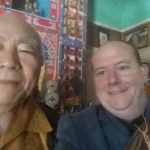Rip Williams
“Whether I’m at a tourist site or when I’m with a nude model, the thought is pretty much the same – ‘how do I take a shot that’s different from what everyone else has taken? How can I take a different shot from what has been taken before?’”
– Rip Williams, fine art & commercial photographer
For photographer Rip Williams, a camera has always been a part of his life. For as long as he can remember, there’s always been a camera at the ready to take snapshots of whatever caught his fancy. But it wasn’t until he was a junior in high school that he really began to take photography seriously, both as a hobby and a vocation.
“My father gave me a screw-mount Asahi-Pentax spot-matic SP1,” recalled Williams. “A serious camera that forced me to start really thinking about what I wanted to shoot and how I wanted to shoot it.”
Primarily self-taught, Williams began working with models and setting up his own shoots soon after. Working primarily with female models who were his friends, Williams began to evolve a pin-up style that brought more models to his doorstep – soon, he was shooting nudes almost exclusively, a practice that continues to the present day with his Guerilla Photo Group sessions. (link)
“Shooting nudes is a stage that every photographer goes through,” said Williams. “The art nude is a classic simply because people who shoot photos are thinking a lot about what beauty is. When you think about beauty, as a man, you want to take pictures of women, particularly women in either sexy outfits or without any clothes at all.”
To date, Williams has shot hundreds of nude models in his studio. He had his first showing of fine art nudes in 2003 at the Albuquerque Press Club. Shot on a 2.1 megapixel digital camera, the show was a testament to the power of Williams’ ability to light well in the studio and make use of Photoshop in post-production. Since then, he has moved onto to more powerful gear (name?) and his technical abilities have grown, but his attention to detail remains the same.
And while nudes are still interesting enough for him to shoot, he stresses that the point of working with nudes is still about beauty, which isn’t necessarily the same as taking pictures of naked women.
“Anyone can take pictures of boobs,” said Williams with a wry smile. “What’s really interesting is using the beauty of the nude to take a compelling shot that transcends the nude. When I’m mentoring other photographers, I always encourage them not just to take a picture but to design a shot that presents a message. I really want for the viewer to get a sense of who the model really is. I want you to see that they’re fun, interesting, and interested for that matter. Sexy is really secondary to what I’m after.”
A lot of what makes a subject interesting to Williams, in addition to the framing of a shot, is how the lighting accentuates the subject and creates negative space in the frame. Beyond designing the shot itself, a lot of what makes Williams’ work successful lies in how it is lit.
“On all my shoots, personal and commercials, a lot of the interest comes down to how we can make lighting more interesting for the purpose of bringing out the character and beauty of the subject, whether it’s a beautiful woman or an object. That’s the goal – to bring out the character of the subject. And the lighting is the method for reaching that goal.”
In addition to his studio or landscape work, Williams also shoots stock and product images that would be of interest to anyone who needs classic New Mexico images such as a green chile in a wine glass or the perfect photo of a freshly painted canvas. In fact, there’s very little that Williams can’t shoot, once he sets his lens and his technical abilities to it.
“I have a joke about how I’ll never shoot weddings, dogs, or children, but in reality I’ve shot all three and I’ll probably do it again.”
The key to getting Williams’ attention is to have strong intentions about capturing something great, regardless of the subject matter. This dedication to detail has earned him many commercial clients, as well as a number of print credits for the Alibi and three cover shot credits for Albuquerque Arts magazine. If your project requires great shooting and killer shots, then Williams’ is probably the shooter you want for your next project.
“What I love most is working with people who really want something expressive and out of the ordinary,” he said. “Shooting with intention is what makes a great image, and that’s what I start with, every time I shoot.”
February 19th, 2018 by sandyadmin
